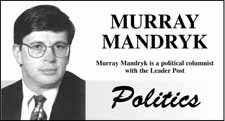Short-lived Progressive Conservative Prime Minister Kim Campbell was sadly wrong when she said an election is no time to debate ideas.
Yes, elections are about determining who should govern us. That's unquestionably a major consideration worthy of our attention.
But within that decision should be a discussion about which ideas are best for us. And it's important that the best ideas don't get lost in the horse-race questions of who is ahead, who is likely to win and whom we simply like best.
Come the Nov. 7 vote in this province, there would seem little doubt that the answer to those questions will be Brad Wall and the Saskatchewan Party. Besides the fact that this province hasn't had a one-term government in nearly 80 years, the reality is that Wall is just overwhelmingly popular compared with NDP leader Dwain Lingenfelter.
However, it's Lingenfelter and the NDP that appear to have come up with the first big idea in this campaign that's worthy of discussion. In fact, it's an idea so good that it shouldn't be lost in what may be essentially in the popularity contest.
The NDP leader's bright idea is literally called the Bright Futures Fund and the concept may already be familiar too you. It's roughly modelled after a similar savings fund in Alaska and another in Norway. Really, though, the best comparison may be the Alberta Heritage Fund that has seen non-renewable resource wealth invested for future generations.
Exactly what the money would be used for is something with which Lingenfelter and the NDP are more than a little vague. How much we should set aside as opposed to use to pay down debt and whether it's accumulated through additional royalties taken from potash, gas and oil companies are serious questions that could have a negative impact on us if not dealt with correctly. As suggested earlier, the details of what's being proposed are worthy of election debate.
But less debateable is the value in the concept - the notion that oil, gas and potash are one-time resources and extracting all of the wealth now without leaving some legacy for future generations of Saskatchewan people is both selfish and poor management.
At least conceptually, it makes infinite sense to at least give serious consideration to this idea - something that even the Sask.
Party government seems to be grudgingly admitting.
Reacting to the NDP's first major proposal, Energy Minister Bill Boyd said it's a idea his own government might consider in the future, but quickly pointed to the government's rainy-day Growth and Financial Security Fund (GFSF) as something similar.
Unfortunately, the GFSF is mostly accounting jiggery-pokery aimed at justifying deficit budgets. Really, it is nothing like what Lingenfelter and the NDP have proposed.
While it's possible that a Bright Futures Fund could be used to balance the books in desperate times, what's critical is that it would accumulate additional wealth through interest or investment. Even more critical is that it would be professionally and independently managed, arms length away from government so future administrations couldn't mess with it strictly for their own political gain.
That's generally how Norway's Sovereign Wealth Fund works. Started in 1996, it's now accumulated $550 billion in mostly pension fund assets that account for two per cent of all stock trade in Europe and one per cent of all stocks that change hands around the globe. This, from a country with only has five million people and only after 15 years of existence.
Frankly, one can only wonder why NDP or Sask. Party governments didn't think of this idea before. Even politically speaking, it's a great way to stop unions and others from clamouring for their share of the current economic boom.
It's an idea that we need to be talking about in this election campaign - regardless of who is presenting it.
Murray Mandryk has been covering provincial politics for over 15 years.




